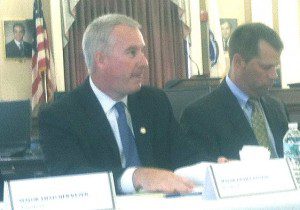
Westfield Mayor Daniel M. Knapik, left, sits next to Northampton Mayor David Narkewicz and awaits his turn to speak at Somerville City Hall yesterday. (Photo by Peter Francis)
SOMERVILLE – While it rained outside onto the streets of the Commonwealth’s most densely populated city yesterday morning, the chamber of Somerville’s City Hall was buzzing with activity, as fourteen of the state’s mayors and town administrators spoke on behalf of the Commonwealth’s Municipal Performance Management Program.
Funded through Governor Deval Patrick’s Community Innovation Challenge grant, the program was created to assist cities and towns throughout the Bay State in saving taxpayer dollars by introducing performance management technology programs modeled after a program, CitiStat, introduced by current Maryland Governor Martin O’Malley during his first year as Mayor of Baltimore in 1999. CitiStat is itself modeled after CompStat, a crime management program utilized in the 1990’s by New York City.
In 2006, right around the time Somerville Mayor Joseph Curtatone implemented the CitiStat-influenced SomerStat system, it was reported that the CitiStat program had saved the city of Baltimore $350 million, a testament to the program’s efficiency.
Through the Commonwealth’s Executive Office of Administration and Finance, 24 cities and towns are members of the program, accounting for over 1.1 million Bay Staters, roughly seventeen percent of the state’s population.
While the program looks to cut down on unnecessary expenditures and increase efficiency across the board for city and town governments, to simply call it a slash and burn program would be an unfair characterization.
While some communities around the state certainly employ more of a sword than a scalpel when it comes to reevaluating their budgetary concerns, the program was given an enthusiastic thumbs up across the panel, especially from its western Mass. members, most notably Westfield Mayor Daniel M. Knapik, Northampton Mayor David Narkewicz, and the town of Orange’s Town Administrator Diana Schindler.
Following remarks from Curtatone and State Secretary of Administration and Finance Glen Shor, the panel began the discussion, touching on the seemingly limitless ways in which the program has streamlined communities around the Commonwealth.
While Narkewicz spoke of how NorthamptonStat has helped to identify best practices within his city’s police department for the reduction of overtime, and the creation of fire department “scorecard” for informing the city of the department’s successes via its website, Knapik sought to inform the largely eastern Mass. body how the Whip City has modified its services and performance in its own unique ways using WestfieldStat.
“After 20 years in business, I’ve learned that nothing ever stays the same,” said Knapik, referencing his life prior to becoming Westfield’s mayor and the city’s desire to become more efficient, a mindset which, combined with attending a New Mayor Training program put on by UMass-Boston’s Collins Center, led to the birth of WestfieldStat in 2010.
“Working with Mayor (Thatcher) Kezer (of Amesbury) and his AmeStat program inspired me to look at examples of things like sanitation, health regionalization and privatization of services,” Knapik said, before going on to say that the galvanizing issue for him was the condition of the city at the time of his arrival as mayor.
“We have 300 road miles in Westfield, about 50 square miles, and I’m still getting hammered by pothole calls in July,” he said of his early days in City Hall, which led to the throwing together of a team composed of city leaders in Information Technology, the Department of Public Works and even the City Auditor with the sole intention of implementing the tools utilized by Mayor Kezer, one of the first mayors in the Commonwealth to utilize a CitiStat-style program along with Mayor Curtatone’s SomerStat.
Knapik would also go on to say the most important aspect of the implementation of WestfieldStat was the opportunity to “advocate for city service entities.”
“You can’t understand what you’re up against until you measure what’s in front of you,” he said. “I wanted to know how quickly could we respond and how can we improve every year.”
Utilizing the CitiStat model enabled Knapik to reevaluate a DPW that had seen a reduction in manpower and, while still productive, simply wasn’t meeting the tax-payer expectations.
Since WestfieldStat’s inception, Knapik and his team have been able to modify the DPW and enable it to more effectively clean up the city and improve its notoriously treacherous roads.
However, Knapik believes the program is only reaching the tip of the iceberg, and that it holds the potential to impact the holiest of holies when it comes to municipal spending: education.
“I’m a product of a public school education, and an enormous amount of money is spent on schools.” Knapik said. “I want to try and study the spending at local education levels because everyone wants a better product. I know there are places for improvement there.”
After the panel had concluded their testimonials, Shor spoke regarding the future of the Municipal Performance Management Program, and whether the results generated will be enough to keep it a statewide factor after Governor Patrick’s impending departure in 2014.
“Governor Patrick’s leadership has been indispensable regarding data-driven, results-oriented government not just at the state, but also by empowering leaders who want to push it at the local level,” Shor said. “What you’re seeing here today… is just the start of a broader trend not just in Massachusetts.”
When asked as to how many more towns and cities will join the program in the coming year, Shor said he couldn’t say for sure, but that we will see more, assuring that Massachusetts will remain on the cutting edge regarding the use of data-driven technology to improve the lives of state residents.
Follow Peter Francis on Twitter at @PeterFrancisWNG.

